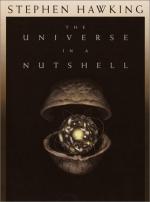
|
| Name: _________________________ | Period: ___________________ |
This test consists of 15 multiple choice questions and 5 short answer questions.
Multiple Choice Questions
1. What can quantum theory represent?
(a) The model of a timewarp.
(b) The dimensions of spacetime.
(c) The shaping of space and time.
(d) The curves of space and time.
2. What is a p = 2 brane?
(a) A wall.
(b) A surface.
(c) A ladder.
(d) A geometrical unit.
3. What does Hawking think is beneficial concerning matter?
(a) Mass is converted into matter from gravitational fields.
(b) Energy is converted into matter from gravitational fields.
(c) Matter is converted into energy from periscopal fields.
(d) Matter is converted into weight.
4. What do models based on imaginary time make?
(a) Innumerable falsities.
(b) Blanket superstitions.
(c) Good predictions.
(d) False predictions.
5. What did Einstein wish people to abandon concerning time?
(a) A general notion of the ratio of time to speed.
(b) A universal notion of time.
(c) That time equals money.
(d) The idea of the 24 hour clock.
6. Where did Einstein accept a position?
(a) The German Academy of Science.
(b) The American Academy of Science.
(c) The Italian Academy of Science.
(d) The Prussian Academy of Science.
7. What does supersymmetry imply?
(a) That particles had a spin property.
(b) That molecules have a spin property.
(c) That strings have a spin property.
(d) That gamma rays have a spin property.
8. What theories of relativity did Einstein advance?
(a) General and perfect.
(b) Special and general.
(c) Normal and placid.
(d) Present perfect and past special.
9. What is one of the twentieth century's greatest discoveries?
(a) There are extraterrestrials.
(b) The earth will be uninhabitable in fifty years.
(c) The universe is expanding.
(d) The universe is collapsing.
10. What do string theories most notably lack?
(a) Proofs.
(b) Numbers.
(c) Dimensions.
(d) Infinities.
11. What did Hawking and Hartle believe the universe may not have?
(a) A narrow scope.
(b) A broad scope.
(c) A time condition.
(d) A boundary.
12. What was discovered in the 1970s that revealed a natural physical mechanism?
(a) A new sort of plane.
(b) A new sort of timewarp.
(c) A new sort of planck.
(d) A new sort of symmetry.
13. What may the universe not have, given quantum mechanics?
(a) Infinite knowledge.
(b) A beginning and an ending.
(c) Five histories.
(d) A single history or every possible history.
14. What can one not curve space without also curving?
(a) Time.
(b) Functions.
(c) Gravity.
(d) Spacetime.
15. Where did Einstein receive his degree?
(a) The Seattle School of Law.
(b) Technical Teaching School.
(c) The Federal Polytechnic School.
(d) Simmons Seminary.
Short Answer Questions
1. How did religious leaders respond to Hawking and Penrose's work?
2. What human conceptions did Einstein's papers change?
3. Which project produced Fat Man and Little Boy?
4. What does Hawking believe we should try to understand?
5. What does Hawking believe any good scientific theory should be rooted in?
|
This section contains 479 words (approx. 2 pages at 300 words per page) |

|




